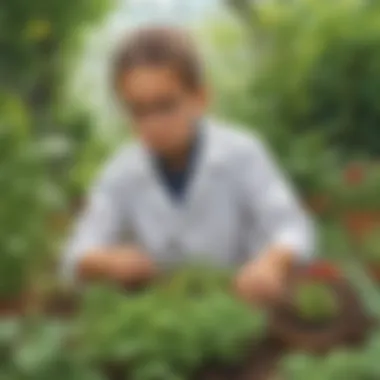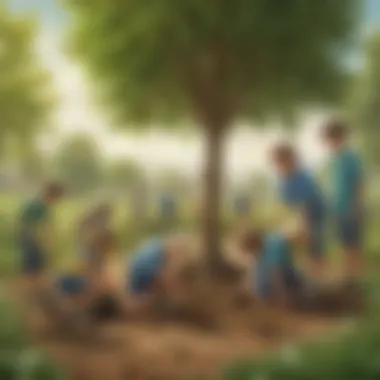Engaging Earth Day Actions for Young Science Lovers


Intro
Earth Day is more than a day on the calendar; it's a call to action for young minds who are curious about the world. As celebrations grow close, it fills a space for engagement and understanding of our planet's needs. With various activities to participate in, this guide points to multiple directions to cultivate a sense of responsibility among children aged six to twelve. Young science enthusiasts will find plenty of fascinating themes to dive into, transforming learning into meaningful action toward a cleaner, greener Earth.
Science Fun Facts
Educators and parents often stress the importance of sparking curiosity in children when it comes to science. Fun facts serve as great conversation starters that ignite imaginations and insights. Consider these interesting tidbits:
- Oxygen Production: Did you know that a single mature tree can produce enough oxygen for two human beings every day? This highlights the vital role trees play in our ecosystem.
- Microplastic Madness: Over 8 million tons of plastic end up in the ocean each year. This alarming fact raises awareness about pollution regarding our water bodies, inviting immediate actions.
- Incredible Numbers: The Earth is home to approximately 8.7 million species. Differentiating between these species is vital to maintaining biodiversity.
“Every Second, about 1,350 tons of plastic is being produced. Let’s understand and take steps against it.”
Beyond these, quirky stories about science can be engaging too. For instance, the proposal of using a particular bacteria to eat excess plastic potentially opens doors for environmental solutions. Children who learn these facts find themselves better primed for action on Earth Day.
Discover the Wonders of Science
Encouraging children to explore science requires varied approaches that can unveil hidden interests more deeply. Utilizing educational videos can make complex subjects digestible.
- Exploring Scientific Concepts: Discussing teams like those innovating in genetic engineering or young inventers making strides in renewable energy can inspire future projects.
- Educational Videos and Animations: Websites like Britannica contain evidence-based resources designed for youthful learners.
- Real-Life Applications: Relate sciences like physics to parachutes and weather to meteorology; this connection broadens understanding.
Tools that nurture experimentation can include virtual instruments that provide safe environments for trials and data collection. Engaging with these tools translates to better grasp of science concepts.
Science Quiz Time
Quizzes are interactive pathways towards consolidating knowledge for children. Tap into that interest by introducing these fun segments:
- Multiple Choice Questions: Distribute questions covering Earth Day facts—This not only evaluates their learning but triggers discussion at the same time.
- Brain Teasers and Puzzles: Different types of challenges can be a great way to keep things interesting, especially in a group setting.
With science already deeply involved in our lives, informing children through gamified methods fosters learning enjoyment.
Science Experiment Showcase
Hands-on activities are perhaps the best ways to inspire younger generations. The relevance of applying knowledge creates excitement along with responsibility. Discussing projects could look like this:
- Fun and Engaging Experiments: Simple processes like making biodiesel from vegetable oil can be made age-appropriate. A small science experiment with eggshells could demonstrate calcium-rich principles at an intriguing level.
- Step-by-Step Instructions: Make experiment sets clear. Draw visuals and include informative literature as necessary to explain each step of the process.
- Materials List: This could span common household items, revealing science doesn't require advanced equipment.
- Safety Tips: Make sure all participants are knowledgeable on what safety gear or actions to take.
Every little experiment enhances the bond with the environment while invoking joy and learning.
Earth Day serves as an important time to embrace our planet by scuba diving into science. Engagement leads to understanding, and long-term awareness in budding naturalists makes a stronger future. Combining excitement with rigor ensures not just participation but also deeper engagement with environmental phenomena.
Understanding Earth Day
Understanding Earth Day is essential for young science enthusiasts. This awareness nurtures their connection to the environment. Knowledge about Earth Day cultivates responsibility. It can lead to informed actions. These actions often aim to protect our planet.
History of Earth Day
Earth Day started in the 1970s. Gaylord Nelson, a U.S. senator from Wisconsin, established this day. Nelson wanted to raise awareness about environmental issues. He saw the need for public education on air and water pollution. The first Earth Day was celebrated on April 22, 1970. It inspired millions. People took to the streets to express concern for the planet. This event became a platform for environmental movement. What began as a national event spread globally. Now, Earth Day is celebrated in over 190 countries.
Purpose and Importance
The purpose of Earth Day is clear. It aims to educate and inspire action. This day reminds people to care for their environment. It encourages young minds to understand issues like global warming. Awareness on pollution, biodiversity loss and climate change is vital.
Participating in Earth Day events helps young people. They learn through fun activities. This knowledge is not just about fun facts. It leads to meaningful long-term behavior changes towards caring for the Earth. Children can influence their communities and impact the planet positively. Data indicates that early environmental education matters. It can shape responsible adults who value ecological health.
"The best way to start is to learn."


Here are some considerations for young enthusiasts on Earth Day:
- Encourage discussions at home about environmental issues.
- Promote participation in local events.
- Inspire curiosity about wildlife and plants.
In short, understanding Earth Day paves the way for future guardians of Earth.
Planning for Earth Day Activities
Planning for Earth Day activities is essential for young science enthusiasts as it offers a structured approach to taking action towards environmental responsibility. These plans create a framework in which children can explore various ecological issues. It is not just about engaging in activities; it is about creating meaning from those actions. Through planning, children develop a sense of ownership and adherence towards their efforts while also enhancing their understanding of significant planetary issues.
Establishing clear goals helps to facilitate focus during activities. Getting concrete and measurable objectives allows them to see the direct impact they make. Additionally, planning provides opportunities for discussion, team-building, and understanding community resources which can enhance their experiences. Children will begin to appreciate the contributions they can make in shaping a better world.
Setting Goals for the Day
The first step in planning for Earth Day is to set meaningful goals. This might include aims like reducing waste, raising awareness, or planting trees. Simply deciding to
Educational Activities
Educational activities are crucial for cultivating engagement and knowledge among young science enthusiasts regarding the environment. These activities provide practical, hands-on experiences, making complex ideas more relatable and understandable. Through such initiatives, children can learn about ecosystems, climate, and sustainability in an interactive manner. Moreover, educational activities stimulate curiosity, encourage teamwork, and foster a sense of responsibility towards nature. This not only enriches their understanding of science, but it also empowers them to take meaningful actions towards helping the planet.
Science Projects Related to Earth Day
Creating Models of Ecosystems
Creating models of ecosystems is a valuable project that allows young learners to explore how different elements within an ecosystem interconnect. This project emphasizes the balance of nature by clearly demonstrating the relationships between living organisms and their environment. The planning and execution of the model require creativity and problem-solving skills. It serves as a beneficial choice because students can visualize concepts that might be abstract in theory.
A unique feature of this project is its adaptability. Kids can use various materials to replicate their local ecosystems, blending art with science. However, one disadvantage could be the resource requirement as some may need supervision, particularly with small parts. Nonetheless, this project delivers profound insights about environmental interdependence.
Conducting Water Filtration Experiments
Conducting water filtration experiments plays an important role in educating young minds about water conservation. This scientific process teaches principles of chemistry and physics while highlighting issues about water pollution and cleanliness. If kids participate in this activity, they grasp the concept of how contaminants get removed from water effectively. Such knowledge fosters an understanding of communal issues related to water scarcity.
The uniqueness of such experiments lies in their practical approach. Students can use household materials to create filters, which keeps the project accessible. However, careful attention must be given to ensure safety while handling materials or testing water samples, which may list possible disadvantages. Despite these challenges, the experiment stands out as an exhilarating way to combine science with real-world applications.
Nature Walks and Observations
Nature walks and observations provide an engaging method for children to connect directly with their surroundings. Through these activities, kids become familiar with specific local plant and animal species, helping to deepen their understanding of biodiversity. More importantly, this proactive engagement with nature prompts a direct appreciation for environmental responsibility. The unscripted nature of a walk encourages exploration, fostering inquisitiveness about nature.
Identifying Local Flora and Fauna
Identifying local flora and fauna guides children to recognize and appreciate the diversity around them. This process cultivates observational skills, enhances the ability to draw connections, and fosters environmental stewardship. The primary benefit kidney is building excitement around what can be discovered just outside their homes or schools. > Children discover the delight of nigg insciously dropping science into daily life.
However, one potential drawback is that the complexity can vary based on the environment. Different places can have different species, making some children hesitant to participate if they see unfamiliar things. Nonetheless, experiencing living ecosystems adds unique contexts to the plants and animals present in their areas.
Recording Environmental Changes
Recording environmental changes is a hands-on activity that sharpens critical thinking skills in young learners. Tracking aspects such as seasonal alterations or the local weather contributes directly to understanding climate change. This practice instills habits of observation, enabling kids to see patterns and recognize the impact of various factors over time. It highlights the ongoing changes Mother Nature presents.
The beauty of this activity lies in its simplicity. Kids only need a basic notebook or a digital app to log their observations while exploring outdoors. On the downside, it may be mentally taxing as learners focus on detailed tracking. Even with any challenges, journaling reflections shows practical applicability while enhancing their scientific reasoning.
Community Involvement
Community involvement is a crucial aspect of Earth Day activities, particularly for young science enthusiasts. Engaging with the community fosters a sense of belonging and teaches valuable skills, including empathy and cooperation. When young people take part in activities that benefit their local environment, they learn the importance of working together to make a difference. Additionally, community events promote collective responsibility, allowing children to see that they are part of a larger effort in addressing environmental issues.
Here are some benefits of community involvement:
- Practical Learning: Kids learn hands-on about environmental challenges and sustainable practices.
- Building Confidence: Participating boosts self-esteem as children realize their efforts contribute to improvement.
- Social Connections: It provides a chance to meet people who also care about the environment.


Involvement in community initiatives presents children with real-world issues. Through these experiences, they gain a deeper understanding of environmental responsibility. This, in turn, can cultivate a lifelong interest in science and sustainability.
Participating in Local Clean-Up Events
Local clean-up events are an ideal way for young people to witness the immediate impact of their efforts on their surroundings. These events are typically organized by schools, community centers, or environmental groups seeking to rid public areas of litter and waste. Children are encouraged to take part, often alongside cannot to supervisors.
Benefits of participating in clean-up events include:
- Visibility of Impact: Kids can see the pollution in their community and help to reduce it completely.
- Healthy Habits: Such events can instill lifelong habits of looking after public spaces.
- Teamwork Skills: Children learn to collaborate with others towards a single goal.
Before joining, here are some considerations:
- Wear proper attire, accordingly shoes, and capture to play safe.
- Check what local groups are organizing events. Look up on sites like facebook.com or local community boards for information.
For finding events, try engaging with fellow families about initiating clean-up projects. Consider bringing small designated bags and gloves for each participant, making it more accessible to assist others as they do this action.
Joining Tree Planting Initiatives
Tree planting initiatives often provide a space for young science lovers to contribute significantly to the environment. Planting trees not only helps in beautifying neighborhoods but also positively impacts ecological health. Trees are essential for promoting air quality, reducing soil erosion, and providing habitats for various wildlife.
Involving children in tree planting has several educational and emotional benefits:
- Understanding Ecology: They learn about ecosystems and biodiversity directly.
- Long-term Commitment: Realizing that trees take years to grow prompts a sense of long-term thinking.
- Sense of Accomplishment: Watching their trees grow enhances attached feelings toward nature.
Participating in tree planting can be quite simple:
- Seek local organizations that run tree planting days.
- Understand soil types for where the trees will be planted and the preferred species in that area.
- It is most rewarding to continue caring for the planted trees after initial procedure, helping solidify the efforts that supports strong community environmental values.
Through both clean-up and tree planting initiatives, the aim is lovely to inspire kids to be proactive about working for a greener tomorrow!
Promoting Sustainability at Home
Sustainability at home is an essential aspect of environmental awareness. Young science enthusiasts can learn valuable lessons about reducing waste and conserving resources. By promoting sustainability, families can coexist with the earth comfortably. Its importance can't be overstated as it embeds responsible behaviors and practices that help in protecting natural resources.
Practical actions taken at home inspire others. Educating young minds about sustainability goes beyond individual actions. It creates a ripple effect where family members, friends, and even neighbors embrace eco-friendly practices. Such engagement cultivates a responsible attitude towards consumption and waste management.
Starting a Recycling Program
Implementing a recycling program at home can be an enjoyable project for children. It teaches them the value of reusing materials instead of sending them to landfills. This project can begin with easily accessible items like paper, plastic, cans, and glass. The first step is to simply set up designated bins in distinct spaces around the house for different materials.
Considerations:
- Clearly label each bin to encourage proper usage.
- Explain how the recycling process works and the environmental benefits it brings.
Children can taken examples from real-life incidents, widening their perspectives on waste generation in their routine activities. This also? promotes critical thinking about reducing waste. By tracking how much was recycled each week, aspiring scientists can measure their progress, gaining insights on how materials are conserved instead of thrown away.
Understanding Energy Conservation
Teaching kids about energy conservation empowers them to make better choices. Understanding this principle is vital, as it connects personal behavior with global environmental health. Simple steps, like turning off lights when leaving a room or unplugging devices, reinforce how individual actions can contribute to a broader solution. Sharing energy-saving strategies with children develops their sense of responsibility.
Actions to Consider:
- Create a checklist to monitor daily energy use.
- Discuss renewable energy sources, explaining their advantages over fossil fuels. This might inspire an interest in sustainability initiatives!
Youngsters might undertake basic experiments to visualize energy consumption, by using energy meters from the library or their school. By connecting these discussions to larger environmental movements, such as climate change and resource scarcity, children gain deeper understanding on how energy waste affects ecosystems.
Creative Expressions


Creative expressions can play a crucial role in celebrating Earth Day, giving young science enthusiasts an opportunity to connect deeply with environmental issues. Engaging in creative activities not only fosters a sense of responsibility toward the planet but also enhances observation skills and encourages critical thinking. These activities help children process their thoughts, feelings, and insights regarding nature and conservation.
By incorporating creativity, children understand that protecting the environment is not merely about actions, but also about sharing ideas. Building their own unique projects can lead to personal expression, allowing them to communicate environmental concerns and solutions in a meaningful way. Fostering creativity also boosts their problem-solving skills, which is essential in crafting innovative solutions for current environmental challenges.
Art Projects Using Recyclable Materials
Art projects using recyclable materials allow children to visualize the importance of recycling in an accessible manner. Using items that are typically discarded to create art not only teaches young minds about waste reduction but also inspires them to see value in what is often thrown away. For example, craft items such as plastic bottles, scraps of paper, and old cardboard can all be repurposed into new sculptures or paintings.
Such projects can help with:
- Understanding sustainability: Kids learn about reducing waste by transforming used items into art.
- Encouraging collaboration: Group art projects let children work together, promoting teamwork and collective thinking.
- Fostering awareness: Each creation can tell a story about the importance of conservation.
An interesting idea could be creating a large mural from bottle caps, which highlights sea life or an underwater scene. This not only beautifies a local space, but also delivers a strong message on plastic pollution.
Writing Stories or Poems on Nature
Writing stories or poems focused on nature captures children’s experiences and impressions, further informing their view of environmental issues. This form of creative expression can be particularly influential as it allows students to elaborate on their observations, thoughts, and feelings related to the environment.
By crafting stories or poems, children can explore various themes such as:
- Biodiversity: Discovering plants, animals, and habitats.
- Ecosystem relationships: Examining how everything in nature is interconnected.
- Personal experiences: Sharing their nature encounters or wishes for a healthier planet.
Encouraging youngsters to participate in poetry readings or story-sharing can deepen their understanding of language as a means of expression. They can also create a little book of stories showcasing different aspects of nature based on their observations during Earth Day activities.
In summary, Creative Expressions empower young minds to express their understanding of environmental conservation, enabling both personal growth and a broader awareness about Earth Day's significance. These kinds of activities ensure that children not only learn about the environment, but also become advocates for its protection.
Utilizing Technology for Earth Day
Engaging with technology is a key aspect that can enhance learning experiences for young science enthusiasts on Earth Day. As young learners explore the environment, technology provides a useful means to gather information, connect with others, and engage in impactful activities. By integrating technology, children can better understand the challenges that our planet faces while fostering an inquisitive mindset towards science and nature.
Engaging with Educational Apps
There is a variety of educational apps tailored for growing minds. These apps focus on environmental science, ecology, and conservation. They offer interactive lessons as well as quizzes designed for younger audiences. Examples include apps like
Reflection and Continuous Learning
Understanding the importance of reflection and continuous learning about environmental activities can greatly enhance a young person's experience.on Earth Day. Engaging fully with nature and activities should not end after just one day. Instead, it should build a foundation for lifelong eco-consciousness.
This section is essential because it allows young science enthusiasts to pause and think about what they have learned. They can review their achievements and disappointments from the day as well. Thus, it helps reinforce key lessons and guides improvement for future efforts. Evaluation also offers young people a chance to take ownership. They reflect on their own understanding and are not solely relying on authority figures for wisdom.
Benefits of Reflection and Continuous Learning:
- Build critical thinking: Reflecting encourages analysis. By considering the outcomes of different activities, kids learn to think critically about their actions.
- Encourage goal setting: Reflecting on what has been learned is a stepping stone to setting further goals. Thus, making reflections purposeful is vital.
- Inspire sharing knowledge: Children often enjoy sharing what they’ve learned. This also benefits their peers and fosters a community of learners.
Considering reflection requires honest evaluation, children may benefit from guidance, especially younger ones. Parents and teachers can help foster discussions around specific reflections of action. This continuous cycle strengthens both cognition and sentiment around caring for the environment.
Evaluating the Impact of Activities
To effectively assess what one has learned from Earth Day events, it'svalant to recognize ways to measure these impacts effectively. Consider the following methods for evaluation:
- Outcomes measurement: Identify the results of activities. Was there a visible decrease in litter after a clean-up?
- Personal mptr here development: Note any learned skills or improved habits resulting from the activities.
- Peer feedback: Gather reactions from peers and friends to provide additional perspectively based feedback.
Encourage young science lovers to keep journals where they can write down their observations and thoughts. Evaluating where improvements can be made will create a greater understanding of their effects on nature.
Setting Future Environmental Goals
Once the assessment of activities is completed, it’s vital to devise future ecological targets. Setting goals guides young people's actions towards a more eco-friendly lifestyle. Suggested incluided actions can be:
- Reduce Water Usage: To conserve water at home and at school by taking shorter showers or using a watering can for plants instead of a hose.
- Clean Up More Often: Organizing or gathering a team for periodic neighborhood cleanup summons persist personali embodied tree planting any wk feels.
- Learn about Renewable Energy: Research renewable body offers insight on how it can be spine naturally improve.
- *Host Awareness Events_: Organize chat please invoking discussions within peers aimed regardinge enthuses changers among emerg youths.
These goals do not needf to be intense, but they should resonate importanceowas thus welding mindea clarity of actions shapes future drive initiatives. Keeping moment focuses on environmental prospects urges soile guidance towards espero creating greater creatures miracles everyday.
It pays to encourage ongoing education and exploration on environmental subjects. The more kids understand their world, the more powerful their impacts, benefiting not only their lives, but the Earth itself in how nature harmonizes—all thanks upon continuing on this enlightening journey.







